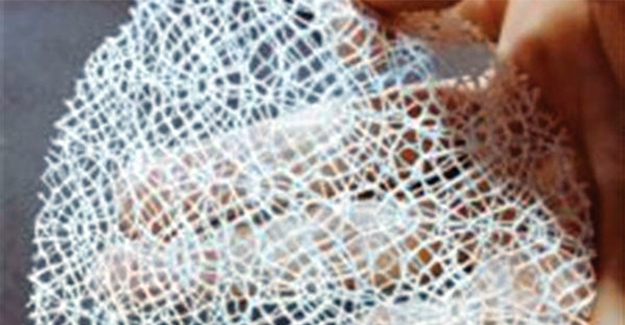
A Traditional Lace Design Results In A New 3D Printed Breast Reconstruction Method
The city of Calais in France is well known for its beautiful lace, which is appropriately called "Calais lace." Produced since the early 1800s, the fabric, distinguished from other types of lace by its unique, trademarked knotting technique, even has a museum dedicated to it - but it's doubtful that the original creators of Calais lace could ever have imagined the use that their design would be put to in the 21st century.
Women who have had mastectomies sometimes choose to follow the procedure with breast reconstruction, but there are risks involved with the current reconstruction methods being used. One of two methods is typically used to reconstruct a breast: a silicone prosthesis, which carries a high risk of rejection and needs to be changed every 10 to 15 years, or lipofilling, which involves grafting fatty tissue from elsewhere and requires multiple surgeries.
Plastic surgeon Pierre Guerreschi of Centre Hospitalier Régionale Universitaire de Lille (CHRU) and biologists Philippe Marchetti and Pierre-Marie Danzé were hoping for a better alternative when they approached Julien Payen, project manager of the Up-Tex textile competitiveness cluster, four years ago.
The medical team was looking for a "scaffolding to maintain fat," said Payen, but it wasn't until he attended a conference on embroidery in Germany that he had the idea of working with the structure of lace. Thus began the MAT (T) ISSE Project, which has resulted in a new type of breast reconstruction procedure that combines the advantages of the two existing techniques with 3D printing & the Calais lace design.
Like lipofilling, the new technique involves the injection of autologous (taken from elsewhere in the body) adipose tissue, but also included in the procedure is a bioresorbable 3D printed scaffold, designed in the Calais lace pattern, plus a shell 3D printed in the same bioresorbable material. MRI images or CT scans are used to design a shell customised to the anatomy of the patient's chest. The fat taken from elsewhere in the patient's body is positioned on the lace scaffold and implanted with the shell. Over the next six to eight weeks, the fat will slowly grow into new tissue to fill out the shape of the shell. Once that has happened, the shell and the scaffold will be absorbed back into the body, leaving the patient with a completely new breast.
The research of the MAT (T) ISSE Project resulted in a startup called Lattice Medical, created through the Eurosanté Bio Incubator, and a patent application, as well as the Théophile Legrand award for textile innovation. According to Payen, however, it will still be some time before the procedure can be clinically tested on humans.
"We have another year or two. We need to improve the process and quality of the product printed in 3D to have something easy to implant," he said. "In the best case, it could be marketed in five years, everything will depend on the next two years and our ability to raise funds to move forward."
Two other companies are currently working on the development of new methods of breast reconstruction as well, although Lattice Medical is the only one to be using textile design as a basis for a 3D printed scaffold.
Textile Excellence
If you wish to Subscribe to Textile Excellence Print Edition, kindly fill in the below form and we shall get back to you with details.








